|
|
|
|
POSSIBLE ASTRONOMICAL OR HERALDIC DATA IN THE BOTANICAL SECTIONS.
Assuming that the bulk of the manuscript concerns astronomy, why would this be bound together and permeated with botany? The only obvious indicator of the botany being medical being f66r, where it looks as though an operation has being performed or care is being given to the figure at the bottom. F66r is contained within a folio that also shows botany and f57v which may be astronomical and specifically relating to SN 1054 at the time of the total eclipse in May of 1054 AD, linking the seemingly unrelated subjects together. I am not expecting the plants sections to contain any major astronomical data. Pharmaceuticals and astronomy sat side by side quite happily in early manuscripts, and sometimes a plant really is just a plant however odd it looks. But, are there any traces at all within the plants that could even remotely be interpreted as astronomical? Only a handful of possible examples can be found and even then they are examined only very speculatively here. Examined by subject matter not page order.
Eagle
|
|
|
|
This root on f46v has been the subject of much debate as to whether it is deliberately drawn to represent an eagle with spread wings. One of the more obvious reasons for this would be that the manuscript was made for Rudolph II as the accompanying letter suggests, another that it could be representative of a crest belonging to the lineage of Tycho Brahe, but it is the national emblem of many countries past and present and is found in many family crests. The eagle has been found in relation to astronomy for millennia as an emblem of the sun, or as a messenger of the sun or other powerful deities. In more modern times it has found its way into astronomical imagery. In 1699, an astronomer named Erhardt Weigel built celestial globes which depicted constellations as the coats of arms of various ruling families/countries, for example, the double headed eagle appears as the constellation Orion. Heraldic eagle bottom right of globe:
http://www.nmm.ac.uk/collections/displayRepro.cfm?reproID=D7851_1&picture=1#content
Information on the globe:
http://www.nmm.ac.uk/collections/explore/object.cfm?ID=GLB0086&picture=1#content
Aquila was 48 constellations described by Ptolemy and represents an eagle, although to the Romans it was Vultur volans, the flying vulture. Sometimes it was shown holding the constellation Antinous (created in 132 AD by the Emperor Hadrian) in its claws, the constellation was finally (1930) merged with Lyre and removed from the sky map.
The constellation Lyre was often portrayed as an eagle holding a lyre in its wings or beak, but later the eagle was lost, it was also one of the constellations described by Ptolemy. Like Aquila sometimes the eagle was portrayed as a vulture instead, Vulture Cadens (falling vulture), otherwise Aquila Cadens (falling eagle).
Examples of the constellation Aquila:
|
|
|
|
|
||||
|
|
|
|
Examples of the constellation Lyre:
|
|
|
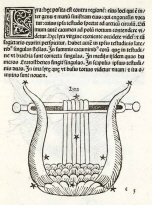 |
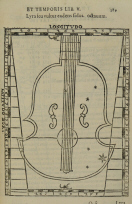 |
|||
|
Lyre. Bayer, Johann. 1603. Uranometria Credit:
Linda
Hall Library of Science, Engineering and Technology |
|
|
|
Examples of eagle in heraldry:
|
|
|
||
|
|
Winged sun disc:
The winged sun disc of ancient civilizations may also be a representation of the solar eagle. Assyrian carvings show warriors accompanied by the god Ashur in the form of an eagle, on other carvings a winged sun-disc is shown instead.
|
|
| A stone relief depicting the Assyrian god Ashur. Source Wikipedia. Public Domain image. |
Dragon
The dragon being shown eating the plant on f25v is not unusual in herbal manuscripts and animals were often added to images to describe the cure performed by the plant, or its name. The dragon is also a solar image in China and the plant with its many petals may be the rays of the sun being eaten by the dragon as was thought to happen during an eclipse in China. The dragon may alternatively refer to the constellation Draco.
|
|
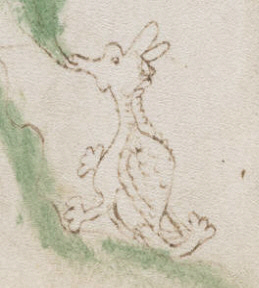 |
||
|
|
|
|
|
|
On the link below is a beautiful example of a Song dynasty dragon in silver and gold from the Musee Guimet, Paris. In comparison to the one fouind in the Voynich Manuscript on f25v is quite similar in style and images of such dragons in Chinese manuscripts along with the details of SN 1054 could have inspired the author.
http://www.historyforkids.org/learn/china/art/pictures/china1000dragon.jpg
Snake
On f43v and f88v there are snake like creatures in the roots. In star maps there are a number of constellations that are illustrated as being snake like, including Draco the dragon. Assuming the various dragon like creates in the Voynich Manuscript refer to Draco then the most likely candidates are Hydra and Serpens, both of which have been illustrated almost identically at one time or another. Hydra is always shown with a single head as a constellation, even though the Hyra of myth was multi headed, but the mythological creature is also often shown as having legs unlike a snake. The image in the root on f88v has what looks like traces of legs whereas the one on f43v has the appearance of a forked tongue making f43v more like Serpens and f88v more like Hydra. However as noted there are quite a few snake like illustrations on star maps.
|
Serpens? |
|
||
|
|
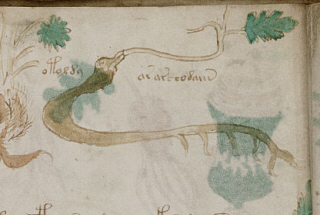 |
||
|
|
Lion?
There is another root on f90v that is said to possibly resemble a lion and was suggested as such by Nick Pelling in 2002. Leo is of course the lion of the sky.
|
Leo? |
|||
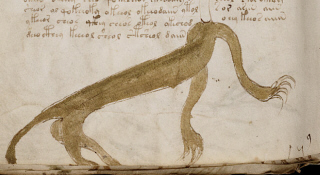 |
|
||
|
|
In comparing the root to Leo on f72r it is striking how similar the pose is.
Cube
|
|
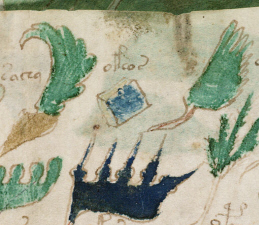 |
|
|
One of the very strange things to be found in the plant section is the cube on f102r. It could represent a mineral of stone, minerals, animal matter and other oddities were sometimes components of medicines, but it is the one and only example of such a geometric shape in the plant section. In ancient China this shape was representative of the world, a cube or square within a circle or sphere. “Tian Yuan Di Fang”, round heaven, square earth. Such images are found on ancient Chinese coins, temples also reflect this view of the universe. Kepler compared the five Platonic Solids to the ordering of the solar system with its five then known planets and attempted to describe the orbits of the planets in terms of these solids, the cube was assigned to Saturn, the sphere surrounding it containing Saturn and marking its orbit. Plato assigned four of the regular solids to the classical elements and the cube to the element "earth".
|
|
|
|
Frog/turtle?
| South? Star? | |||||
|
|
|
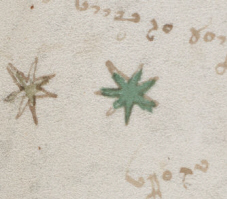 |
|||
|
|
|
The frog or turtle on f101v is one of the few images of creatures in the plant section and would seem to have no obvious connection with astronomy. China had very early on invented compasses, they began as a thin sliver of iron magnetised by heating and cooling floating in water.
The “Sinan” or South indicating spoon, was carved loadstone placed on a square bronze base with a central circle than sometimes had an image of the Big Dipper on it. The square represented the earth and the central circle heaven and as well as marks of divination it was also marked with 24 cardinal directions. Because loadstone aligns with the Earth's natural magnetic field, the handle of the spoon points south. The spoon later was replaced by a needle that had been magnetised by rubbing on the spoon or by heating and cooling. The needle came to be known as a fish or tadpole (or small frog). Some compasses were dry, some floating in water.
|
|
|
|
One later type of the Song dynasty was a “south pointing turtle”.
http://kaleidoscope.cultural-china.com/en/136K2K8.html
To the right of the frog is a star shaped leaf, which is very like the green stars on f67v. In this scenario the frog/turtle may be indicating a star to the south west, or south east depending on it being viewed sky-down or earth-up, the angle between the middle of the frog and the green leaf is approximately 40°. Could alternatively be related to the winter solstice when the sun is at its furthest point south in the sky.
Faces
| 1 face –Earth/Sun/Moon/star? | 2 faces – poles? |
|
|||
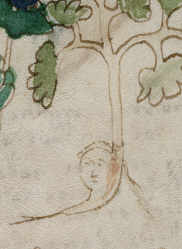 |
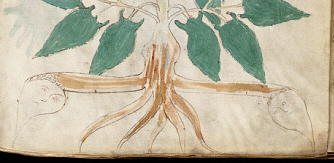 |
|
|||
|
|
|
Faces are found on a number of different roots, this is not an
uncommon way for plants such as Mandrake, however Mandrake was mostly shown with
complete human bodies, male or female. The number of faces on some Voynich
plants are 1, 2 and 5. In relation to astronomy, these numbers could refer to:
1= Sun
Earth
Moon
2= Poles
5= Five known naked eye planets of Antiquity:
Mercury, Venus, Mars, Jupiter, Saturn.
Or they could be specific stars/star groups.
Squiggle
|
|
|
|
A glyph that has appearance of a seated female figure. It could be Cassiopeia, who is the only seated female constellation.
Copyright © 2010 P. Han